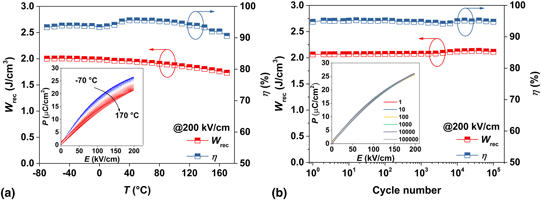Crossref Citations
This article has been cited by the following publications. This list is generated based on data provided by
Crossref.
Zhang, Shujun
Malič, Barbara
Li, Jing-Feng
and
Rödel, Jürgen
2021.
Lead-free ferroelectric materials: Prospective applications.
Journal of Materials Research,
Vol. 36,
Issue. 5,
p.
985.
Wang, Ge
Lu, Zhilun
Li, Yong
Li, Linhao
Ji, Hongfen
Feteira, Antonio
Zhou, Di
Wang, Dawei
Zhang, Shujun
and
Reaney, Ian M
2021.
Electroceramics for High-Energy Density Capacitors: Current Status and Future Perspectives.
Chemical Reviews,
Vol. 121,
Issue. 10,
p.
6124.
Bilal, Muhammad Kashif
Wang, Jian
Bashir, Rabia
Liu, Huan
Asif, Sana Ullah
Xie, Jiyang
and
Hu, Wanbiao
2021.
A novel relaxor (Bi,Na,Ba)(Ti,Zr)O3 lead‐free ceramic with high energy storage performance.
Journal of the American Ceramic Society,
Vol. 104,
Issue. 8,
p.
3982.
Cheng, Xuxin
Chen, Xiaoming
and
Fan, Pengyuan
2022.
Excellent energy storage performance in NaNbO3-based relaxor antiferroeic ceramics under a low electric field.
Journal of Electroceramics,
Vol. 48,
Issue. 4,
p.
198.
Joseph, Jincymol
Cheng, Zhenxiang
and
Zhang, Shujun
2022.
NaNbO3 modified BiScO3-BaTiO3 dielectrics for high-temperature energy storage applications.
Journal of Materiomics,
Vol. 8,
Issue. 4,
p.
731.
Yang, Letao
Kong, Xi
Li, Qi
Lin, Yuan-hua
Zhang, Shujun
and
Nan, Ce-wen
2022.
Excellent Energy Storage Properties Achieved in Sodium Niobate-Based Relaxor Ceramics through Doping Tantalum.
ACS Applied Materials & Interfaces,
Vol. 14,
Issue. 28,
p.
32218.
Singh, Charanjeet
and
Kumar, Ashok
2022.
Improved energy storage density and energy efficiency of Samarium modified PMNT electroceramic.
Ceramics International,
Vol. 48,
Issue. 13,
p.
18278.
Qi, He
Xie, Aiwen
and
Zuo, Ruzhong
2022.
Local structure engineered lead-free ferroic dielectrics for superior energy-storage capacitors: A review.
Energy Storage Materials,
Vol. 45,
Issue. ,
p.
541.
Kumar, Abhinav
and
Asthana, Saket
2022.
Investigations on structural, dielectric, and impedance properties of ecofriendly Ho3+ / Nb5+ co-substituted Na0.5 Bi0.5TiO3.
Journal of Alloys and Compounds,
Vol. 927,
Issue. ,
p.
166958.
Chen, Xiaoming
Cheng, Xuxin
and
Fan, Pengyuan
2023.
Fine-grained NaNbO3-based relaxor antiferroelectric ceramics with high energy-storage performance.
Journal of Materials Science: Materials in Electronics,
Vol. 34,
Issue. 35,
Nguyen, Minh D.
2023.
Towards low-temperature processing of lead-free BZT thin films for high-temperature energy storage performance.
Journal of Alloys and Compounds,
Vol. 959,
Issue. ,
p.
170597.
Khondabi, Mohammad
Ahmadvand, Hossein
and
Javanbakht, Mahdi
2023.
Revisiting the Dielectric Breakdown in a Polycrystalline Ferroelectric: A Phase‐Field Simulation Study.
Advanced Theory and Simulations,
Vol. 6,
Issue. 1,
Yang, Letao
Qi, Junlei
Yang, Mingcong
Fu, Jing
Liu, Yiqian
Lan, Shun
Yang, Bingbing
Meng, Fanqi
Ren, Weibin
Zhang, Xinyue
Cai, Jinghan
Lin, Yuan-Hua
Guo, Jinming
Kong, Xi
and
Nan, Ce-Wen
2023.
High comprehensive energy storage properties in (Sm, Ti) co-doped sodium niobate ceramics.
Applied Physics Letters,
Vol. 122,
Issue. 19,
Yadav, Abhinav
Sahoo, Sushrisangita
Singh, Sukhanidhan
Raevski, I.P.
and
Sarun, P.M.
2023.
Influence of Mn-doping on the structure, high-temperature dielectric, and conductive properties of NaNbO3 ceramics.
Materials Science and Engineering: B,
Vol. 297,
Issue. ,
p.
116796.
Guo, Huitao
Zeng, Fangfang
Xiao, Wenrong
Jiang, Shenglin
Chen, Yuxin
Wang, Bowen
Fan, Guifen
Lu, Wenzhong
and
Tu, Zhengkai
2023.
Optimized energy storage performance in BF-BT-based lead-free ferroelectric ceramics with local compositional fluctuation.
Journal of the European Ceramic Society,
Vol. 43,
Issue. 11,
p.
4774.
Guo, Huitao
Zeng, Fangfang
Xiao, Wenrong
Jiang, Shenglin
Chen, Yuxin
Wang, Bowen
Fan, Guifen
Lu, Wenzhong
and
Tu, Zhengkai
2023.
Realizing high energy density in BiFeO3-based ceramics capacitors via bandgap engineering and polarization optimization.
Chemical Engineering Journal,
Vol. 461,
Issue. ,
p.
142071.
Maiwa, Hiroshi
Sakurai, Atsushi
Zhao, Kang
and
Liu, Yugeng
2023.
Effects of MnO addition on structure and electrical properties of lead-free antiferroelectric 0.96NaNbO3–0.04CaZrO3ceramics.
Ferroelectrics,
Vol. 602,
Issue. 1,
p.
33.
Zhang, Jinbo
Pu, YongPing
Hao, Yuxin
Zhang, Lei
Wang, Bo
Ning, Yating
and
Chen, Min
2023.
Antiferroelectric-like BiFeO3-SrTiO3 based ceramics with high breakdown strength and energy-storage density.
Journal of Alloys and Compounds,
Vol. 968,
Issue. ,
p.
172147.
Li, Weiqiu
Wang, Shibin
Lin, Changli
Yu, Yuliang
Zhao, Xiaobo
Yao, Yingbang
Tao, Tao
Liang, Bo
and
Lu, Sheng-Guo
2024.
Enhanced energy-storage density in (Pb0.98La0.02)(Zr0.45-xSn0.55Hfx)0.995O3 antiferroelectric ceramics.
Scripta Materialia,
Vol. 242,
Issue. ,
p.
115959.






